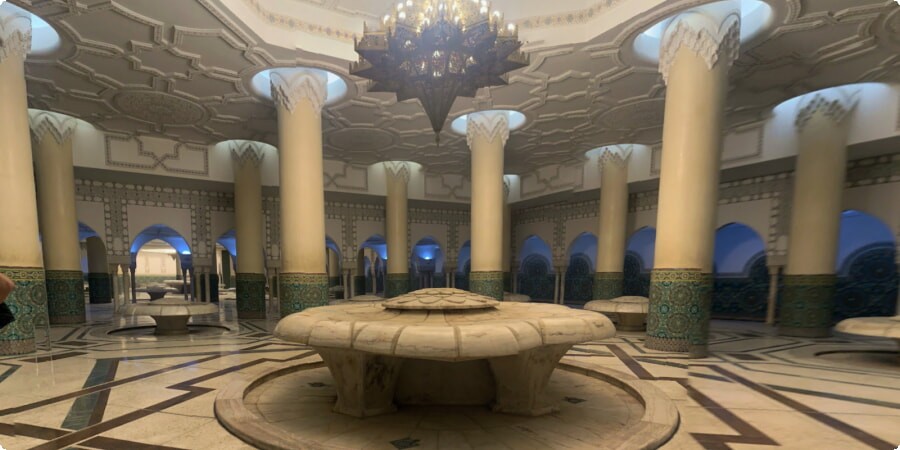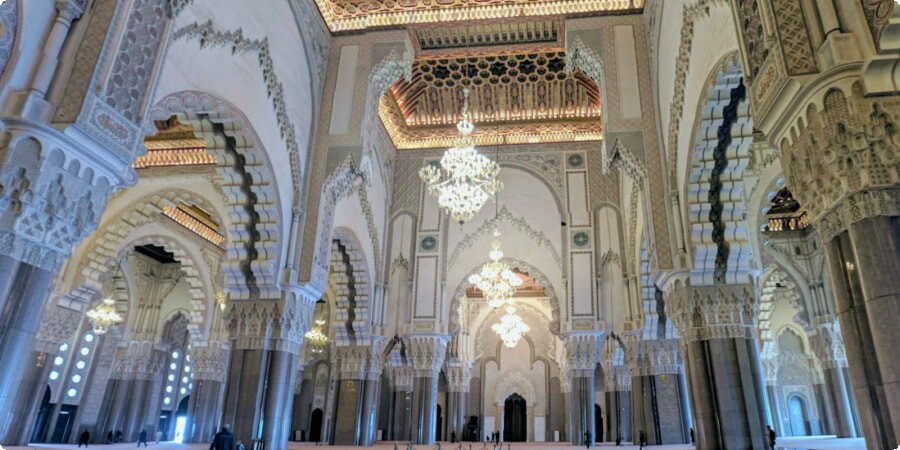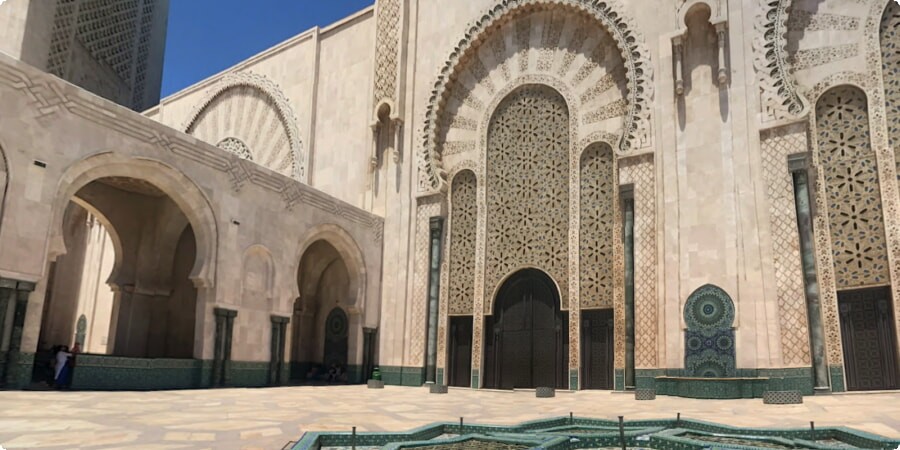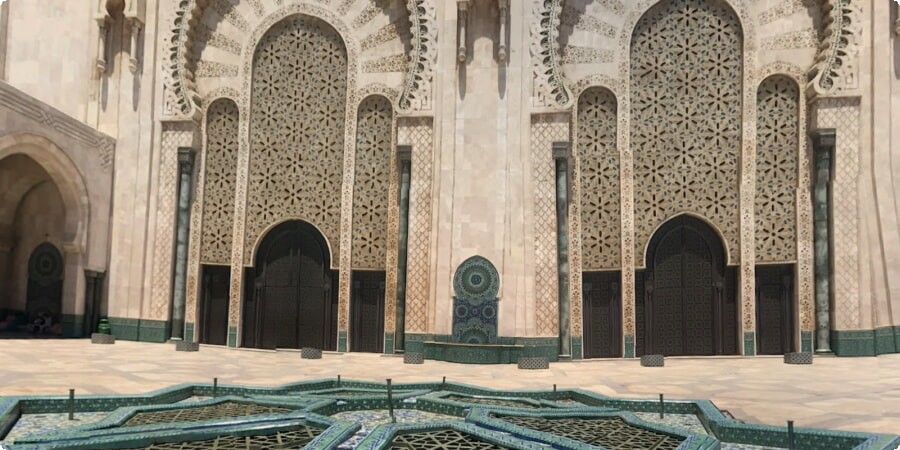Nestled along the picturesque coastline of Casablanca, the Hassan II Mosque stands as a testament to Morocco's rich architectural and cultural heritage. This awe-inspiring structure, often referred to as Casablanca's crown jewel, is not only a place of worship but also a symbol of the nation's artistic and engineering prowess. With its towering minaret, intricate designs, and breathtaking views of the Atlantic Ocean, the mosque attracts visitors from around the globe. In this article, we will explore the historical background, architectural marvels, artistic elements, technological innovations, cultural significance, and visitor information about the magnificent Hassan II Mosque.
Historical Background
The Hassan II Mosque, one of the largest mosques in the world, was commissioned by King Hassan II and completed in 1993. The vision for this grand mosque was rooted in the desire to create a monumental structure that would showcase Morocco's rich cultural and architectural heritage. The location was carefully chosen to symbolize the connection between land and sea, with part of the mosque extending over the Atlantic Ocean.
Construction began in 1986 and involved the efforts of over 10,000 artisans, craftsmen, and laborers. The project was a colossal undertaking, requiring the use of traditional Moroccan materials such as marble, wood, and mosaics. The mosque's construction was funded through donations from the Moroccan people, reflecting its importance as a national treasure. For more details about the history of this remarkable mosque, you can refer to its Wikipedia page.
Architectural Marvel
The Hassan II Mosque is a true masterpiece of modern Islamic architecture. Designed by French architect Michel Pinseau, the mosque seamlessly blends traditional Moroccan architectural elements with contemporary design. The mosque covers an area of 22 acres and can accommodate up to 25,000 worshippers inside, with room for an additional 80,000 in the courtyard.
One of the most striking features of the mosque is its minaret, which stands at a staggering 210 meters, making it the tallest minaret in the world. The minaret is adorned with intricate tile work and calligraphy, showcasing the exquisite craftsmanship of Moroccan artisans. The prayer hall is equally impressive, with its enormous retractable roof that can be opened to allow natural light to flood the interior.

The use of local materials, such as marble from Agadir and cedar wood from the Middle Atlas Mountains, adds to the mosque's grandeur. The intricate zellige (mosaic tilework) and carved stucco further enhance the beauty of the mosque, making it a visual feast for visitors. If you're planning to visit Casablanca, don't miss the opportunity to explore the Hassan II Mosque. And if you're traveling from Marrakech, consider booking a car at Marrakech Airport for a comfortable journey. You can easily book a car here.
In conclusion, the Hassan II Mosque is not just a place of worship; it is a symbol of Morocco's rich cultural heritage and architectural brilliance. Whether you are an architecture enthusiast, a history buff, or a spiritual seeker, a visit to this magnificent mosque is sure to leave you in awe.
Artistic Elements
The Hassan II Mosque is a testament to the extraordinary artistic craftsmanship that Morocco is known for. The mosque’s interior and exterior are adorned with a myriad of intricate details that reflect the rich heritage and artistry of Moroccan culture.
One of the most striking artistic elements is the zellige, or mosaic tilework, that decorates many parts of the mosque. Each tile is carefully hand-cut and arranged into complex geometric patterns, showcasing a remarkable level of precision and artistry. These mosaics are not only visually stunning but also symbolize the infinite nature of the universe, a key concept in Islamic art.
Another highlight is the carved stucco work, which embellishes the mosque’s walls and arches. This intricate plasterwork features floral and geometric patterns, created by skilled artisans who have mastered this traditional technique over generations. The mosque’s ceilings are equally breathtaking, with elaborate wood carvings and vibrant painted designs that add to the overall grandeur.
The use of marble, sourced from quarries in Agadir, further enhances the mosque’s opulent aesthetic. The marble is meticulously carved and polished to create smooth, flowing surfaces that catch the light beautifully. Additionally, the mosque features exquisite brass and bronze work, including chandeliers and doors, which are crafted with intricate patterns and calligraphy.
For those interested in the artistic heritage of the Hassan II Mosque, a visit to the mosque is a must. The attention to detail and the sheer scale of the artistic elements make it a truly unique experience.

Technological Innovations
The Hassan II Mosque is not only an architectural marvel but also a feat of modern engineering. The construction of the mosque incorporated several technological innovations that set it apart from other mosques around the world.
One of the most notable features is the mosque’s retractable roof. This massive structure can be opened to allow natural light and fresh air to enter the prayer hall, creating a unique and adaptable worship space. The roof’s mechanism is a remarkable engineering achievement, combining traditional design with modern technology.
The mosque is also built to withstand natural disasters, such as earthquakes. Advanced engineering techniques were used to ensure the stability and durability of the structure, making it one of the safest buildings in Morocco. The foundation of the mosque extends into the Atlantic Ocean, requiring innovative construction methods to protect it from the harsh marine environment.
Another impressive feature is the mosque’s extensive use of solar energy. Solar panels are integrated into the design, providing a sustainable source of power for lighting and other electrical needs. This commitment to environmental sustainability is a forward-thinking approach that aligns with Morocco’s broader goals for renewable energy.
The mosque’s sound system is also state-of-the-art, designed to provide clear and even acoustics throughout the vast prayer hall. This ensures that the imam’s voice can be heard clearly by all worshippers, enhancing the overall experience.
If you’re planning a visit to the Hassan II Mosque and wish to explore more of Morocco, consider renting a car for a convenient and comfortable journey. You can easily book a car here.
Cultural and Spiritual Significance
The Hassan II Mosque holds immense cultural and spiritual significance for both Moroccans and visitors. As one of the largest mosques in the world, it serves as a major center for Islamic worship and cultural activities.
For the local Muslim community, the mosque is a place of prayer, reflection, and community gathering. Its location by the sea is symbolic, representing the divine connection between the earth and the heavens. The mosque’s call to prayer, resonating from the tallest minaret in the world, is a powerful reminder of faith and devotion.
The mosque is also a cultural hub, hosting various events and festivals throughout the year. These include religious celebrations, educational programs, and cultural exhibitions that showcase Morocco’s rich heritage. The mosque’s library and museum offer additional insights into Islamic art, history, and culture, making it an important educational resource.

Visitors from around the world are drawn to the mosque’s grandeur and beauty, as well as its spiritual ambiance. Guided tours are available, providing a deeper understanding of the mosque’s architecture, history, and significance. The experience of standing in this majestic space, surrounded by intricate art and architecture, is truly awe-inspiring.
For many, the Hassan II Mosque is more than just a building; it is a symbol of Morocco’s identity and pride. It represents the country’s commitment to preserving its cultural heritage while embracing modern advancements. Whether you are a devout Muslim or simply an admirer of beautiful architecture, the Hassan II Mosque offers a profound and enriching experience.
In the next sections, we will provide practical information for visiting the mosque and share personal experiences from those who have been captivated by its beauty. Stay tuned for more insights into this magnificent landmark.
Visiting Hassan II Mosque
Visiting the Hassan II Mosque is an unforgettable experience, offering a glimpse into the grandeur of Moroccan architecture and spirituality. To make the most of your visit, here are some practical tips and essential information:
Opening Hours and Tours: The mosque is open to visitors at specific times outside of prayer hours. Guided tours are available in multiple languages, including English, French, and Arabic, providing detailed insights into the mosque's history, architecture, and cultural significance. It is recommended to check the official website or contact the mosque in advance for the latest tour schedules and ticket prices.
Dress Code and Etiquette: As a place of worship, the Hassan II Mosque has a strict dress code. Visitors should dress modestly, with shoulders and knees covered. Women are required to cover their heads with a scarf. Shoes must be removed before entering the prayer hall, so it’s advisable to wear easily removable footwear. Respectful behavior and quiet demeanor are expected during the visit.
Getting There: The mosque is located along the Boulevard de la Corniche in Casablanca, easily accessible by taxi, public transport, or car. For those traveling from other parts of Morocco, renting a car can provide a convenient and flexible way to explore Casablanca and its attractions. You can book a car here for a hassle-free travel experience.
Nearby Attractions: After visiting the mosque, take some time to explore the surrounding area. The Boulevard de la Corniche offers stunning views of the Atlantic Ocean and is lined with cafes, restaurants, and shops. The Old Medina, a bustling market area, is also nearby, offering a vibrant atmosphere and a chance to experience local culture and cuisine.

Personal Experiences
Visitors from around the world have shared their awe and admiration for the Hassan II Mosque. Here are a few personal experiences and testimonials that highlight the impact of this magnificent landmark:
John from the USA: "Standing inside the Hassan II Mosque was a humbling experience. The sheer scale and beauty of the architecture took my breath away. The intricate details, the play of light through the stained glass, and the serene ambiance made it one of the most memorable places I’ve ever visited."
Amina from France: "As a Moroccan living abroad, visiting the Hassan II Mosque was a deeply emotional journey. It was wonderful to see the preservation of our cultural heritage and the pride of our people. The guided tour was informative, and I left with a greater appreciation for the artistry and craftsmanship involved in its construction."
Luca from Italy: "I was fascinated by the technological innovations in the mosque, especially the retractable roof and earthquake-resistant design. It’s a perfect blend of tradition and modernity. The view of the Atlantic Ocean from the mosque’s terrace was spectacular. I highly recommend it to anyone visiting Casablanca."
These personal stories reflect the universal appeal and profound impact of the Hassan II Mosque. Whether it’s the architectural beauty, the spiritual ambiance, or the cultural insights, every visitor finds something unique and inspiring.
The Hassan II Mosque is not just a mosque; it is a symbol of Morocco's rich heritage, artistic excellence, and modern ingenuity. From its majestic minaret to its intricate mosaics and innovative engineering, the mosque stands as a beacon of faith, culture, and community.
Visiting the Hassan II Mosque is an experience that goes beyond sightseeing. It offers a journey into the heart of Moroccan identity and spirituality, leaving a lasting impression on all who step into its grand halls. Whether you are drawn by its architectural splendor, its cultural significance, or its serene atmosphere, the Hassan II Mosque promises an enriching and unforgettable experience.
Plan your visit, respect its sanctity, and immerse yourself in the beauty and history of one of the world’s most magnificent landmarks.